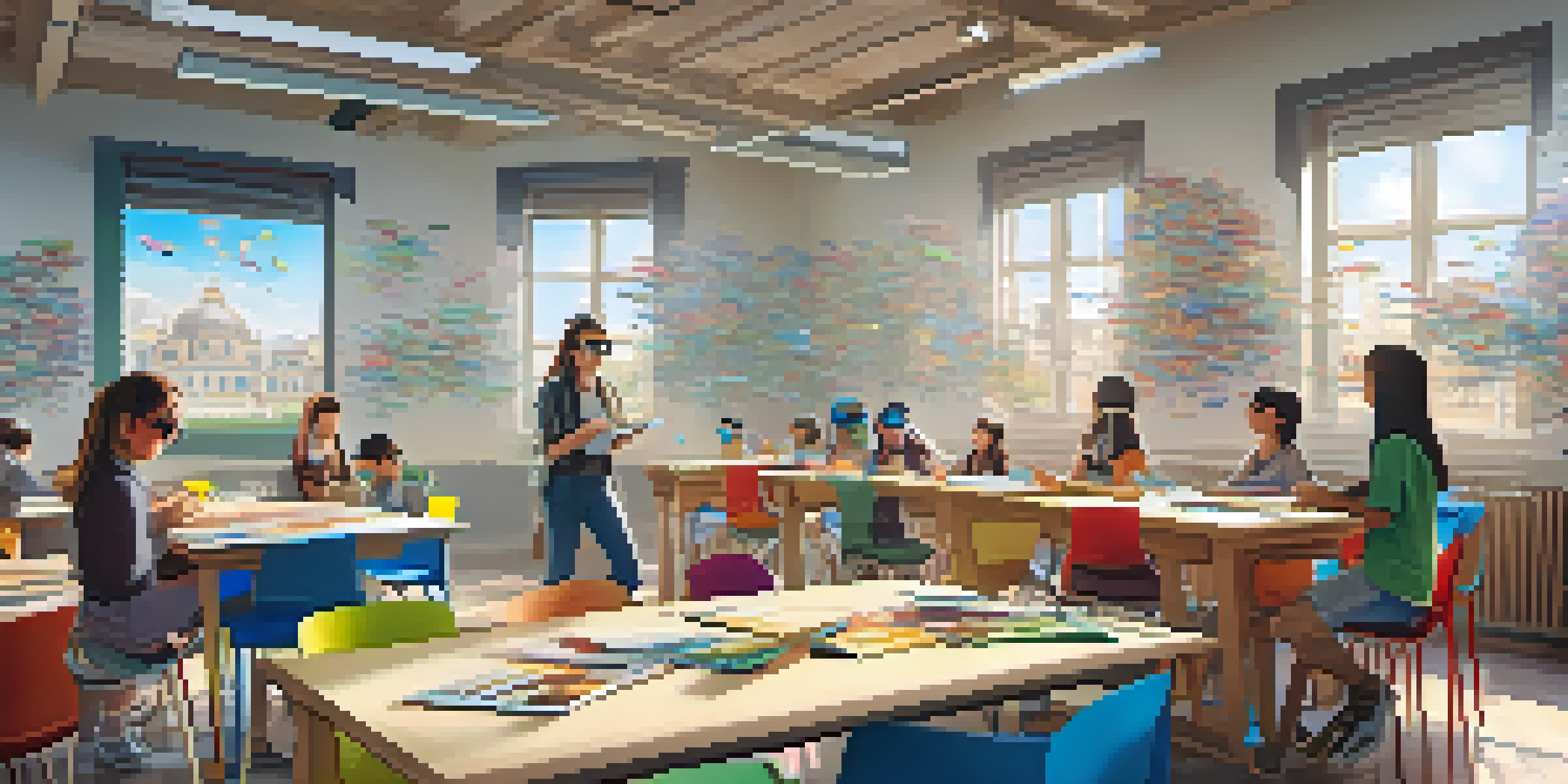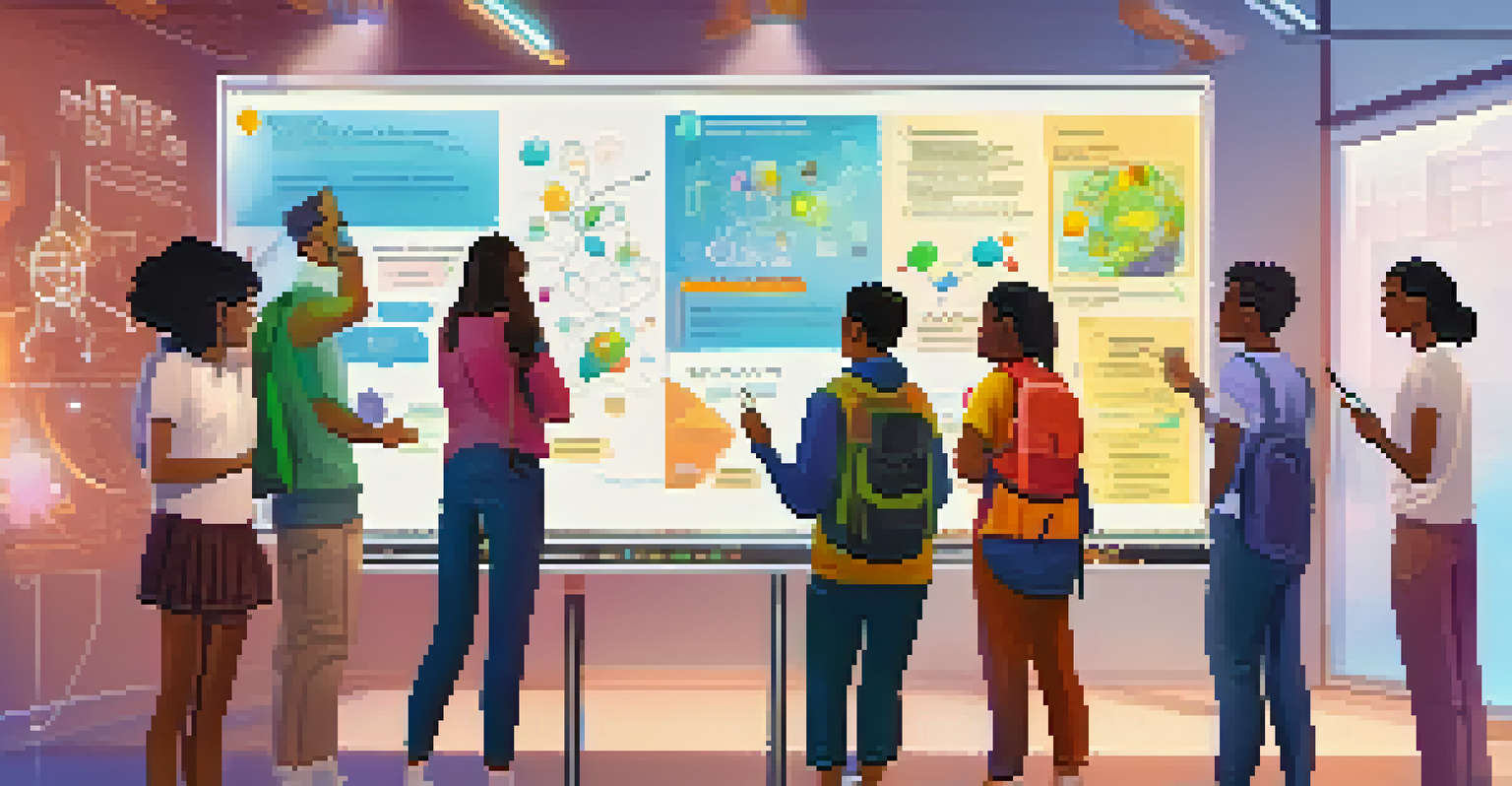AR and Collaborative Learning: A New Approach

Understanding Augmented Reality in Education
Augmented Reality (AR) blends digital content with the real world, creating immersive experiences. Imagine wearing AR glasses that overlay information onto your surroundings; that’s the power of AR in education. It allows students to interact with 3D models or simulations, making abstract concepts more tangible and easier to grasp.
Technology is best when it brings people together.
In a classroom setting, AR can transform learning into an engaging adventure. For instance, a history lesson can come alive when students can virtually walk through ancient cities or witness historical events unfold. This not only captivates attention but also helps students retain information better by engaging multiple senses.
Moreover, AR promotes curiosity and exploration. When students can visualize what they’re learning, they’re more likely to ask questions and seek deeper understanding. This lays the groundwork for collaborative learning, as curiosity often leads to group discussions and shared discoveries.
The Role of Collaborative Learning in Education
Collaborative learning emphasizes teamwork, where students work together to solve problems or complete tasks. This approach fosters communication and social skills, essential for thriving in today’s interconnected world. By sharing ideas and perspectives, students learn from one another and develop critical thinking skills.

Additionally, collaborative learning encourages a sense of community and belonging among students. When learners collaborate, they feel more connected, which can enhance motivation and engagement. This supportive environment allows for risk-taking and innovation, essential elements for effective learning.
AR Enhances Engagement in Learning
Augmented Reality captivates students by transforming lessons into interactive experiences that promote better retention and understanding.
As students work together, they also learn to value diverse viewpoints. This not only enriches their educational experience but also prepares them for real-world scenarios where collaboration is key. The synergy created in collaborative learning settings can lead to deeper understanding and greater creativity.
How AR Enhances Collaborative Learning
Integrating AR into collaborative learning creates a dynamic learning environment. Imagine a group of students using AR to visualize complex scientific processes together. This shared experience not only makes learning more interactive but also encourages teamwork as they navigate challenges collectively.
The beautiful thing about learning is that no one can take it away from you.
AR tools can facilitate real-time collaboration, allowing students to work on projects regardless of their physical location. For example, using AR applications, students can brainstorm ideas on a virtual whiteboard, making remote collaboration seamless and effective. This flexibility is especially important in today’s digital age.
Furthermore, AR can help break down barriers among students. Different learning styles can be accommodated as AR offers multiple ways to engage with content. Whether through visual aids, interactive simulations, or gamified experiences, AR ensures that everyone has a role to play in the collaborative process.
Examples of AR in Collaborative Learning
Several educational institutions have started to embrace AR for collaborative projects. For instance, one university developed an AR application that allows students to conduct virtual science experiments together, regardless of their physical location. This not only enhances their learning experience but also fosters teamwork as they navigate the experiment together.
Another example is the use of AR in language learning. Students can engage in virtual language exchanges where they practice speaking with peers while interacting with AR elements, such as vocabulary games. This immersive experience encourages collaboration and helps build their confidence in using the language.
Collaborative Learning Builds Community
Working together in groups fosters communication and social skills, creating a sense of belonging that enhances motivation and engagement.
These examples illustrate how AR can provide unique opportunities for collaborative learning. By incorporating technology into group activities, educators can create engaging and meaningful experiences that enhance understanding and retention of information.
Benefits of AR in Collaborative Learning Environments
The benefits of using AR in collaborative learning are numerous. First and foremost, it enhances engagement, as students are drawn into an interactive world that makes learning feel more like an adventure. This heightened interest often translates into better academic performance.
Additionally, AR helps cater to different learning styles. Visual learners can benefit from 3D models, while kinesthetic learners can interact with virtual objects. This inclusivity ensures that all students can participate and contribute to group activities, fostering a more equitable learning environment.
Finally, AR encourages the development of essential skills like problem-solving, communication, and teamwork. As students collaborate in AR environments, they learn to approach challenges collectively and think critically, preparing them for future endeavors in both academic and professional settings.
Challenges of Implementing AR in Collaborative Learning
While the potential of AR in collaborative learning is exciting, there are challenges to consider. One significant hurdle is the need for technology infrastructure. Schools must invest in devices and software, which can be a barrier, especially in underfunded areas.
Another challenge lies in teacher training. Educators need to be comfortable with AR technology and understand how to integrate it into their curriculum effectively. This requires ongoing professional development and support to ensure teachers feel confident in using AR to enhance collaborative learning.
Challenges in AR Implementation
Despite its benefits, implementing AR in education faces hurdles such as the need for technology infrastructure and teacher training.
Lastly, there may be concerns about screen time and its impact on students. Striking a balance between traditional learning methods and AR experiences is crucial. Educators must ensure that AR complements the curriculum rather than overshadowing essential learning practices.
The Future of AR and Collaborative Learning
As technology continues to advance, the future of AR in collaborative learning looks promising. We can expect to see more innovative applications that make learning even more interactive and engaging. Imagine students using AR to collaborate on projects in real-time, regardless of their geographical locations.
Furthermore, the integration of AI with AR could personalize learning experiences based on individual student needs. This would allow for tailored collaborative activities that enhance the strengths of each group member, fostering a more effective learning environment.

Ultimately, the combination of AR and collaborative learning has the potential to revolutionize education. By creating immersive, engaging experiences, we can inspire the next generation of learners to work together and explore new horizons.